Disclosure: Meeple Mountain received a free copy of this product in exchange for an honest, unbiased review. This review is not intended to be an endorsement.
In recent years publisher EmperorS4 has been a reliable source of interesting small-box games, their Hanamikoji series being a standout.
Hanamikoji is one of the best two-player games around, and for my money it’s easily the most memorable I-cut-you-choose game I’ve ever played, at once uncompromising and comedic. Geisha’s Road added new cogs to Hanamikoji’s original tug-a-war battle; it lacks the same lacerating edge but is more thoughtful and knotty. Meanwhile Shadows in Kyoto is the adopted sister, more of a Hanamikoji-flavoured take on Stratego than a blood relation, and slightly weaker for it.
2024 brings a new baby to the family in the form of Kimono Memories. It’s an altogether softer experience from the plots and subterfuge of its elder sisters whilst still retaining some of the same features in its chubby little face. This fundamental difference might put you off or you may find the friendlier gameplay more inviting.
A Snapshot
This time round, you and your opponent are photographers, visiting Kyoto and trying to amass the best photo portfolio of traditional kimonos, the national dress of Japan.
As with Hanamikoji and Geisha’s Road there are a series of battlegrounds you’ll be vying to win, although in this case it’s not the favour of individual geisha you’re looking to gain but photos of five different kimono cloth patterns. Each turn you take a ‘Beauty’ card from the circular display and add it to your album, moving the pattern marker of that card type one space towards you. If you’ve managed to connect a matching pattern symbol with the card you’ve placed it next to then bravo, you can move that pattern marker too.
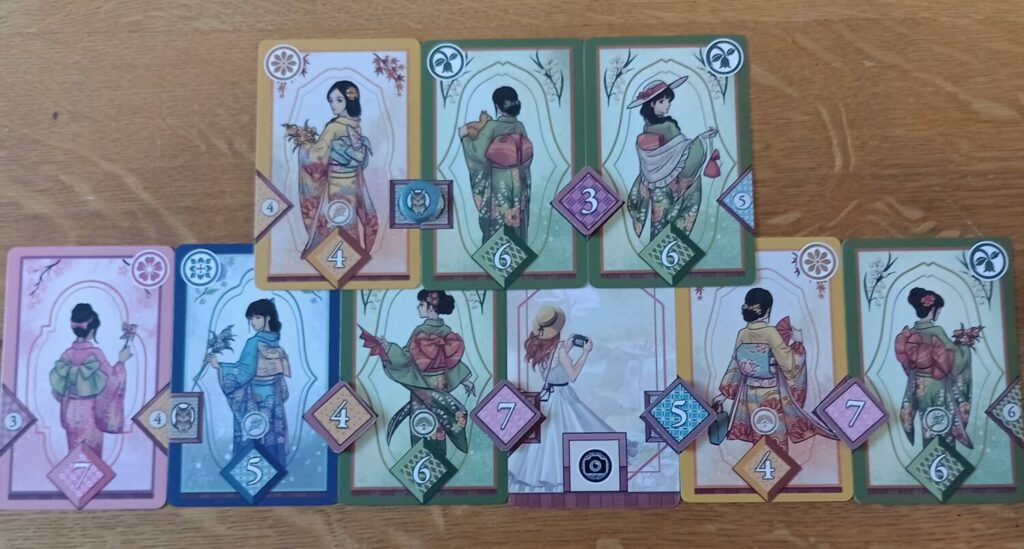
In the basic game that’s about it – take a card, add it to your album to extend a line or start a new line overlapping an existing one, and move the corresponding marker(s). As the game goes on those five pattern markers move backwards and forwards until the cards run out and the player with the majority of pattern markers on their side of the line wins, with cat symbols on the cards used as a tie-breaker.
In the expert mode, Kimono Memories becomes a points game. Here the pattern majorities are only one of four different scoring areas, with cats and additional icon types on the ‘Beauty’ and ‘Prop’ cards providing the bulk of the points. It’s a step up in terms of what you need to think about but the basic process remains the same.
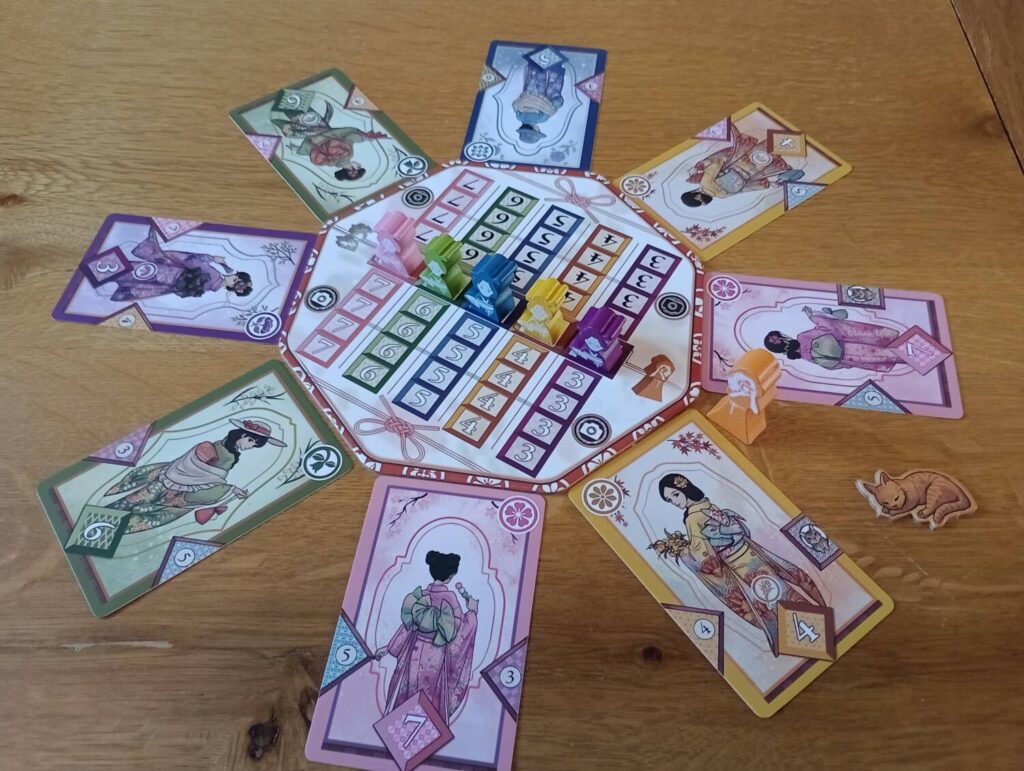
Of course, what I’m missing out here is how you collect those cards. In keeping with the series it’s, in theory, a delicate balance between what you want yourself and what you don’t want your opponent to get. The cards are arranged in a circle and on your turn you can take one of the next three cards clockwise from the photographer pawn. Of course, your opponent can then take one of the three cards clockwise from where you leave the pawn…
Cottoning On
Kimono Memories has a very different vibe to its older siblings. This feels both intentional and an accidental consequence of the design.
Let’s start by exploring what Kimono Memories does right because, remember children, different doesn’t mean bad.
Understanding which card to choose for yourself and where to place it is a lovely spatial puzzle. Not particularly deep but, in keeping with its subject matter, it’s very pleasant and interesting. Once you move to the advanced game that pleasantness doesn’t go away, but the mental calculations of which symbols to prioritise this turn get more involved.
I could take card A which is a pink pattern and has a yellow pattern symbol that would line up, or I could take card B which has a matching green pattern and an Umbrella symbol but the card is a purple pattern which I don’t need more of and it’s Mono symbol is on the wrong side, or I could take card C which provides me points for collecting Fan symbols which I don’t have many of yet but I might do in a few turns time. What’s the best card to score me the most points?
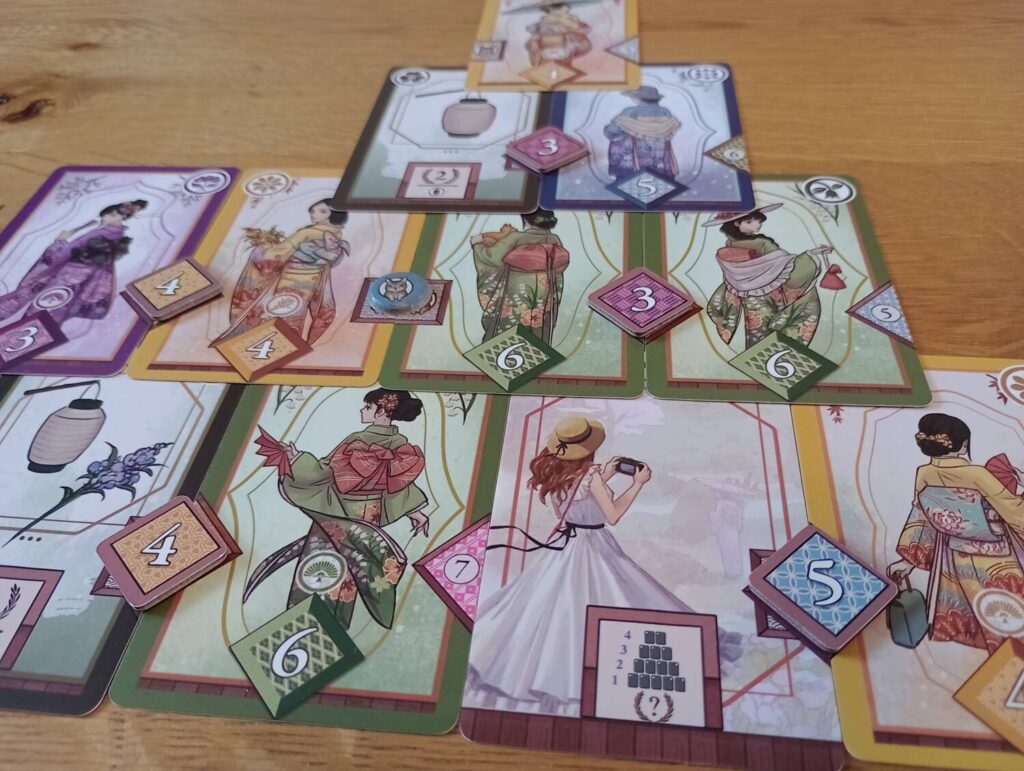
Whilst a lot of the advanced scoring elements are hard to compare, the pattern markers dithering between you and your opponent keep it interesting too. They put pressure on you both to react to each other’s moves. You end up wanting to shore up patterns where you’re leading whilst also retrieve patterns your opponent has an advantage in. Of course, you can’t do everything and it’s in that weighing of which card is best where the game shines.
This is all heady stuff and I can highly recommend giving Kimono Memories a whirl for this alone.
Hemped In
However, the reason I highlighted the movement of the pattern markers is that visually understanding the rest of your opponent’s game state is tricky.
The card market has cards arranged in a circle – some facing towards you, some towards your opponent and some at angles in between. For matching up your own pattern symbols on card edges this can cause the occasional spatial error of judgement, and doubly so when looking at your opponent’s upside-down cards across from you. (Sitting side-by-side helps, you can align the cards in the market towards you both at least.)
But in the expert game, with all the other symbol types and multipliers on the cards, it’s even harder to understand what your opponent might be collecting and what cards they might want. Think about the thought-example from above. Now try thinking about that for what you also don’t want to leave available for your opponent. Now try doing that but looking at their information and some of the cards in the market upside-down.

If you can’t quickly assess their game state, how can you make decisions about what to try and prevent them from taking?
What’s more, whilst the pattern markers influence both players (me gaining a pink pattern means you losing one), the rest of the scoring avenues are individual. My gaining another Fan icon doesn’t affect your score at all. And, as I said, it’s really those other areas of the game that tend to score at least half (if not two-thirds) of the points, subtly minimising the impact of the patterns.
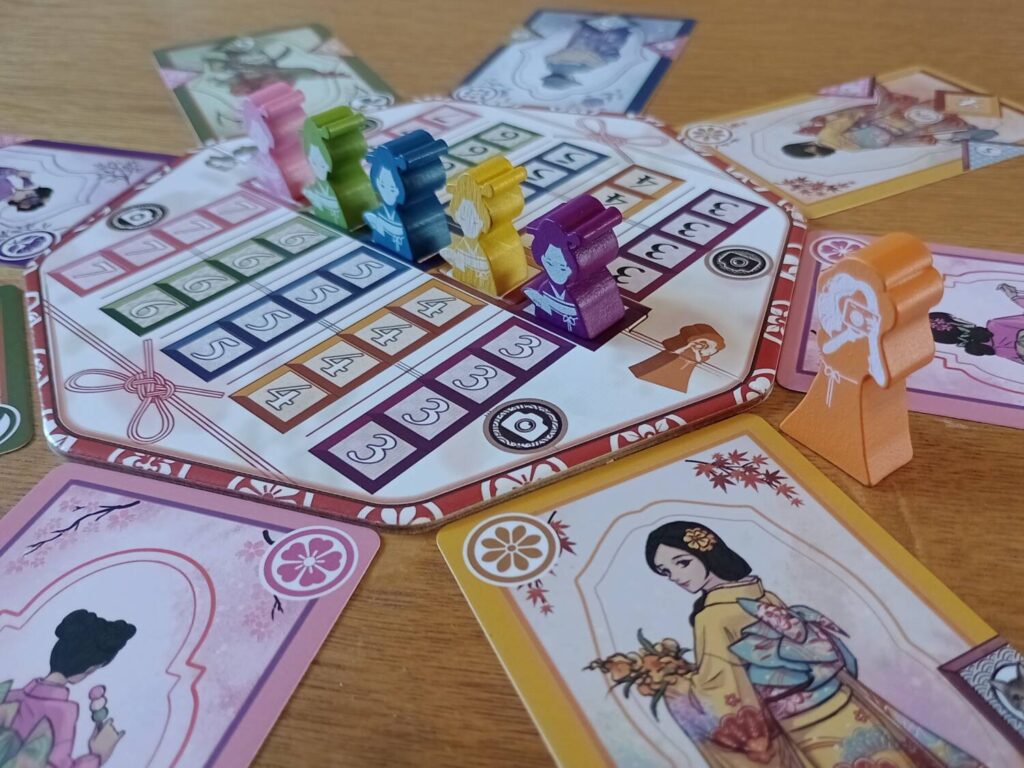
The result is a game which suggests that you’re weighing up what you want against what your opponent wants, but in reality the scales tip far more towards your own area and your own interests.
None of this is a bad thing and it certainly doesn’t feel lonely. Navigating your own path to points becomes more interesting as the game goes on, and the push-pull of those pattern markers adds some flair to the process. But it’s a gentler and less confrontational experience, tonally different from the direct interaction of its ancestors. Without the pattern markers I’m not sure it would fit the Hanamikoji name.
Needle Point
If you truly want the teasing agony of the original Hanamikoji then play Kimono Memories alone. A first for the series, it’s an excellent, easy to control and quick solo game. Your opponent (‘Fanny’, no snickering at the back please) simply takes the card behind the one you select, adding it to their photo album in the most beneficial way.
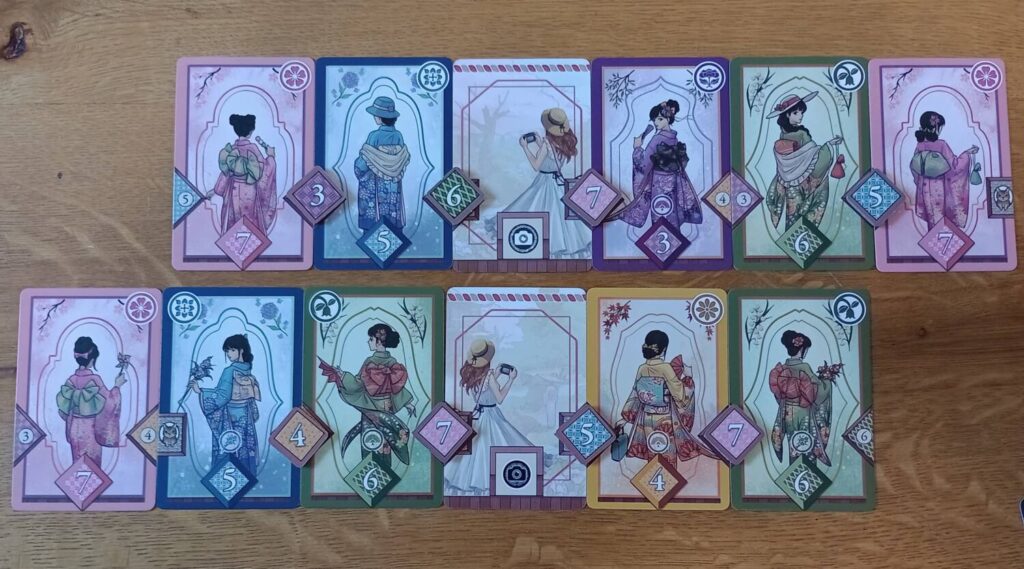
The solo game is more like the introductory game in terms of how to win, but it has all the hallmarks of the older members of the family. Everything is crystal clear. You know which card Fanny will take, so you know exactly how it’ll affect the positioning of the pattern markers. It emphasises the choice between ‘what I want’ and ‘what I don’t want them to have’. It’s also surprisingly hard! I’ve beaten Fanny once so far (I said no snickering) and am enjoying trying to repeat the achievement.
Fuku Fashion
The art helps Kimono Memories to complement the series too. My word is it a good-looking game. Maisherly Chan continues to be one of the best game artists around and Kimono Memories is simply lovely. Like with the gameplay, her work on Kimono Memories has its own distinct tonal style from the others, but it’s very much in keeping with the series and is a visual delight, all elegant soft tones and wistful lines.

Whilst the rulebook mentions you getting ‘captivating glimpses of kimono-clad beauties’, the representation of said beauties is modest. For those concerned that a game about taking photos of women might be seedy, Kimono Memories reassures in the same way that its predecessors did about geisha. Titillating this is not, and the line in the rules about ‘seeking permission to capture these elegant figures’ is rather wonderful.
Kimono Memories wasn’t quite what I was expecting from the Hanamikoji name. It hits some of the beats of the series whilst managing to have its own distinct personality. For me it doesn’t have quite the same degree of memorability as Hanamikoji itself, but it’s very good despite that.
Pleasant if not pointed.


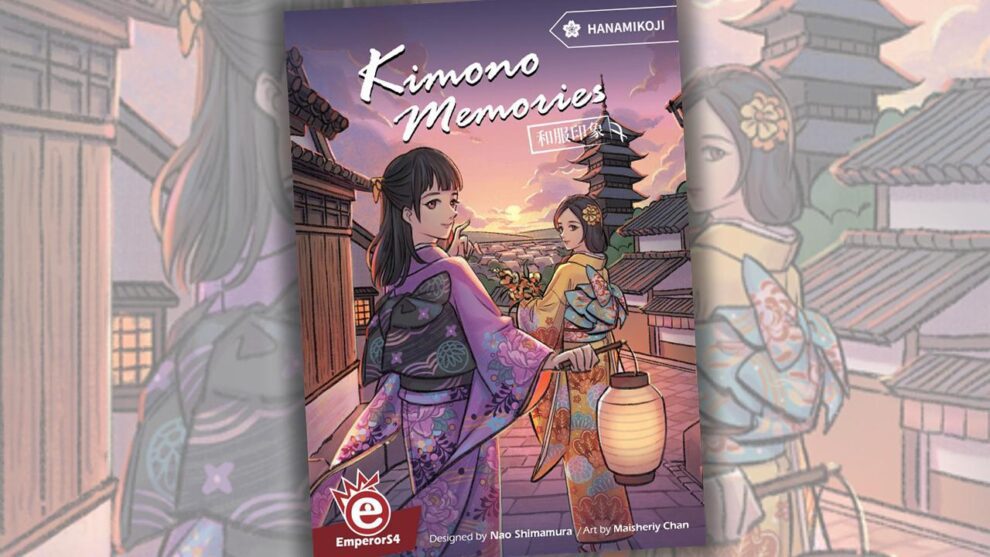
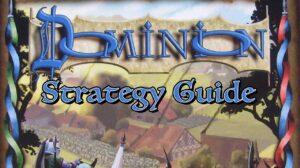







Add Comment